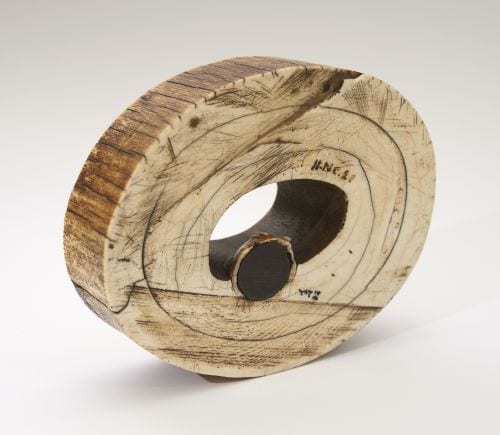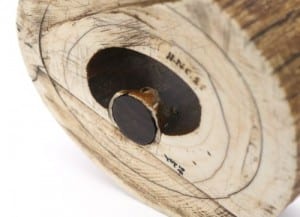Specimen of the Week: Week 181
By Tannis Davidson, on 30 March 2015
 At the Grant Museum we have nearly 68,000 specimens – and each, in its own way, has a story to tell. Some are historical specimens dating back to the earliest days of the Museum such as Professor Grant’s thylacine skeleton and the popular walrus penis bone.
At the Grant Museum we have nearly 68,000 specimens – and each, in its own way, has a story to tell. Some are historical specimens dating back to the earliest days of the Museum such as Professor Grant’s thylacine skeleton and the popular walrus penis bone.
Others tell more modern tales of use in the collection for teaching (SOTW 178), undergoing conservation work (Return of the Rhino), or being featured in exhibitions (SOTW 180).
This week’s Specimen of the Week has several stories to tell and as such, I’ve always thought it one of the most interesting specimens in the collection. It is…
**The Elephant tusk section with a bullet**
1. Once upon a logbook
According to the Museum’s specimen logbook, this section of Asiatic elephant tusk was acquired by the Museum between 1900-1901. It is listed as specimen 1522 and described as “section of tusk of elephant showing secondary denture around a bullet”. The logbook entry specifying where/how this tusk was obtained merely states ‘ Stock’. As far as historical documentation goes, this is pretty good. Certainly any information is better than nothing, but to come so tantalisingly close to having a complete history of the specimen is a bit of a heartbreak to the modern curator. Hindsight (and best collection management practice) dictates ‘the more the better’ approach to museum documentation in effort to create the most complete records so that future stewards of the collection may have as much information as possible.
2. Pulp non-fiction
So what’s going on here? As you can see in the image on the right, (and as described in the logbook), a bullet is lodged in this tusk and dentine has grown around it. This suggests that 1). the shot was not fatal because 2). regrowth has occurred. In elephants, about 1/3 of the tusk is hidden from view inside the skull within the premaxilla (the fused cranial bones of the upper jaw which hold the tusks). The interior of this part of the tusk contains the pulp cavity which consists of blood, tissue and nerves (in comparison to the ‘tip’ end of the tusk which is solid dentine with an outer layer of cementum and enamel on the tip). Therefore, this section has been taken from the upper end of the tusk as the pulp cavity is visible. The nutrient rich pulp cavity generated the dentine growth around the bullet in response to the injury which would have effectively sealed the nerves and thus limited pain reception.
3. CSI Zoology
Lack of forensic ballistics training aside, when examining this specimen the direction of the shot can be determined. It is firmly lodged in the edge of the pulp cavity on the side of the section which has the larger centre void. This means that the bullet is in the upper part of the section of tusk rather than the lower tip end. As the tip end of the tusk bears no evidence of entry, the shot must have entered the tusk from back not the front. So rather than this being a missed front head shot, the shot hit the elephant at the back of the protruding premaxilla, whereby the bullet penetrated this bone and entered the tusk. Perhaps the elephant turned its head just as the gun was fired and as a result, prevented a fatal injury.
The bullet itself appears to be a round lead shot and is a rare historical size corresponding to an 11 gauge (bore) gun. The size and type is consistent with the larger guns produced at the end of the 19th century by Europeans encountering large animals and hunting them for self-protection, food gathering and (later) for sport. These big guns (including so-called ‘elephant guns’) were heavy and powerful but often lacked the velocity to penetrate thick bone such as the “toughest shot of all : defeating the bone mass for a frontal brain shot on an elephant” (Fadala 2006). Clearly, this shot did penetrate bone, but the lack of high velocity of the shot is evidenced by the fact that the tusk was not completely shattered (and instead absorbed the bullet).
4. Cautionary tale
Perhaps the most obvious story that this specimen tells is that of the continued conflict between man and animals. Unfortunately, illegal hunting and trade of endangered species persists alongside human-animal conflict due to competition over decreasing land. Over-exploitation resulting from the ivory trade (made possible by the use of firearms) has severely threatened the survival of elephant species. Both Asiatic and African elephants also face losing their habitats as human populations and their agricultural activites increase. When farming encroaches into elephant habitat the inevitable damage to crops by elephant raids often leads to hostilities (or worse) on both sides.
A poignant symbol of the history of conflict between man and elephant, this specimen hopefully transcends its past and can inform attitudes which will ensure a sustainable future for elephants and other endangered species.
![Wild Elephants, Munnar Aruna at ml.wikipedia [CC BY-SA 3.0 (http://creativecommons.org/licenses/by-sa/3.0)], via Wikimedia Commons](https://blogs.ucl.ac.uk/museums/files/2015/03/WildElephantsMunnar.jpg)
Wild Elephants, Munnar. Copyright Aruna at ml.wikipedia [CC BY-SA 3.0 (http://creativecommons.org/licenses/by-sa/3.0)], via Wikimedia Commons
References
1. Fadala, Sam 2006. “They were after ivory”. The Complete Blackpowder Handbook. Iola, Wisconsin: Gun Digest Books. pp. 404–412.
 Close
Close



